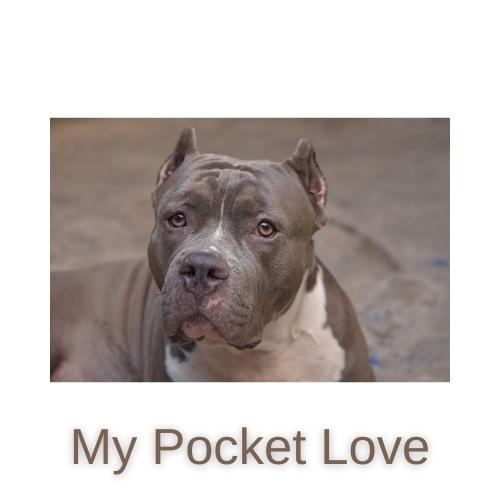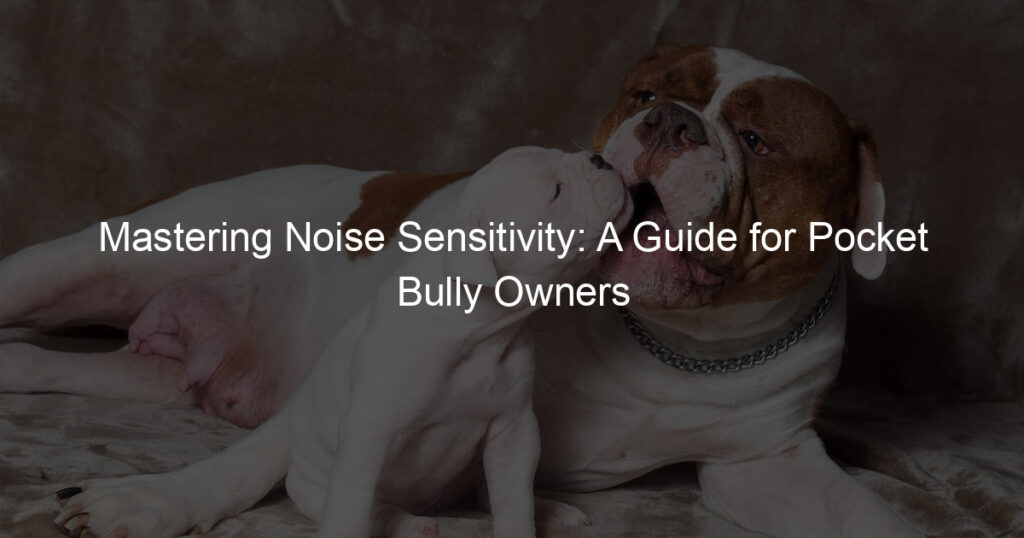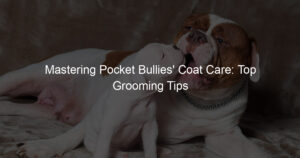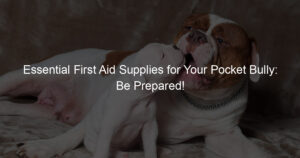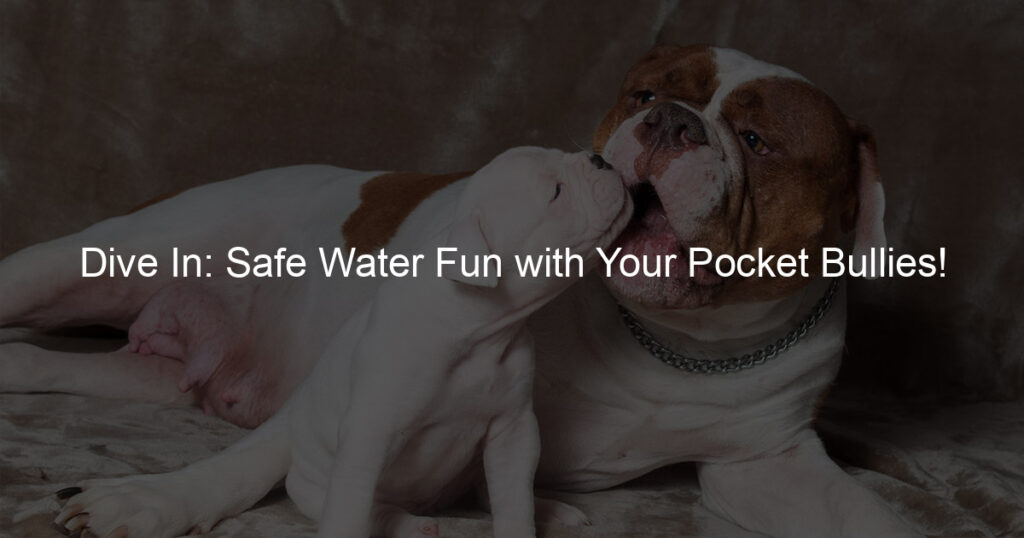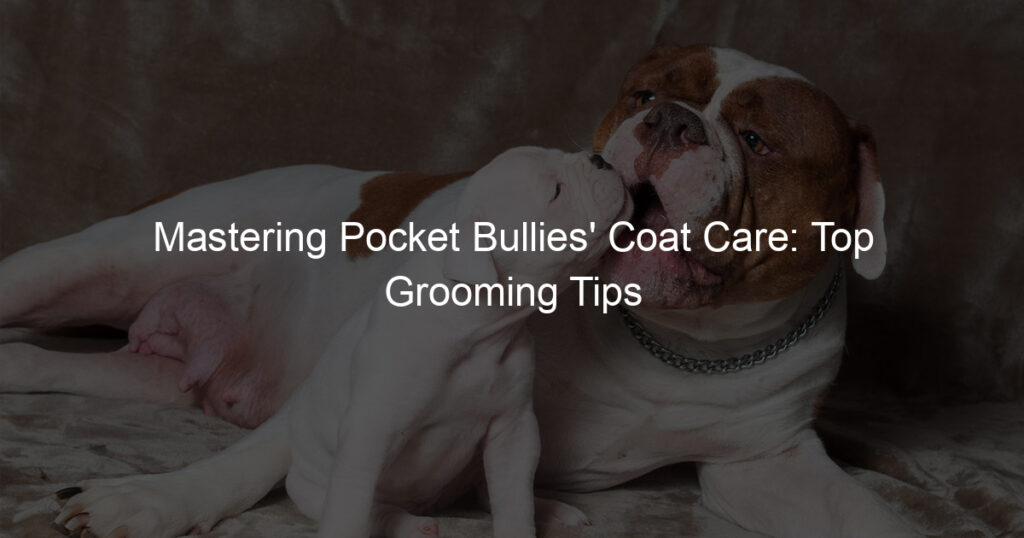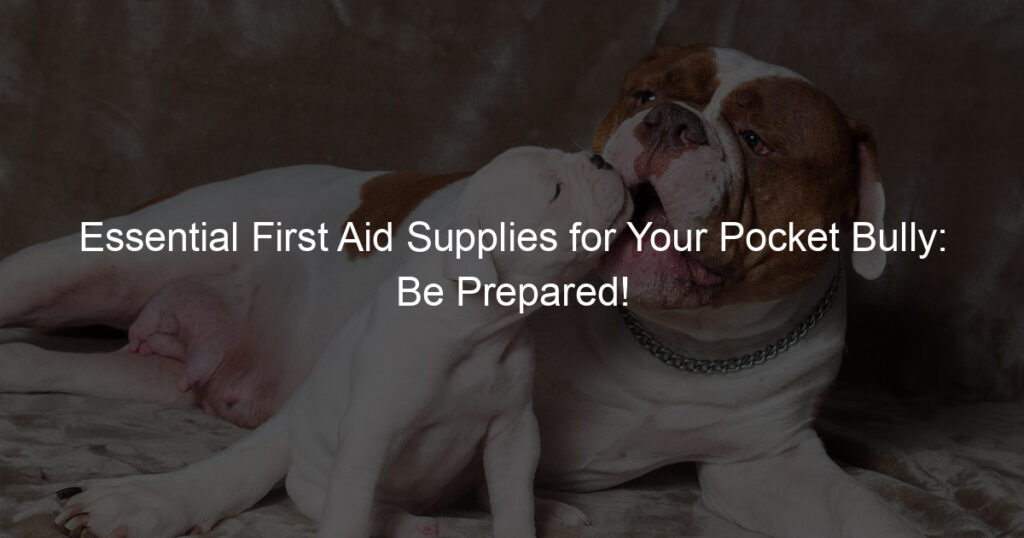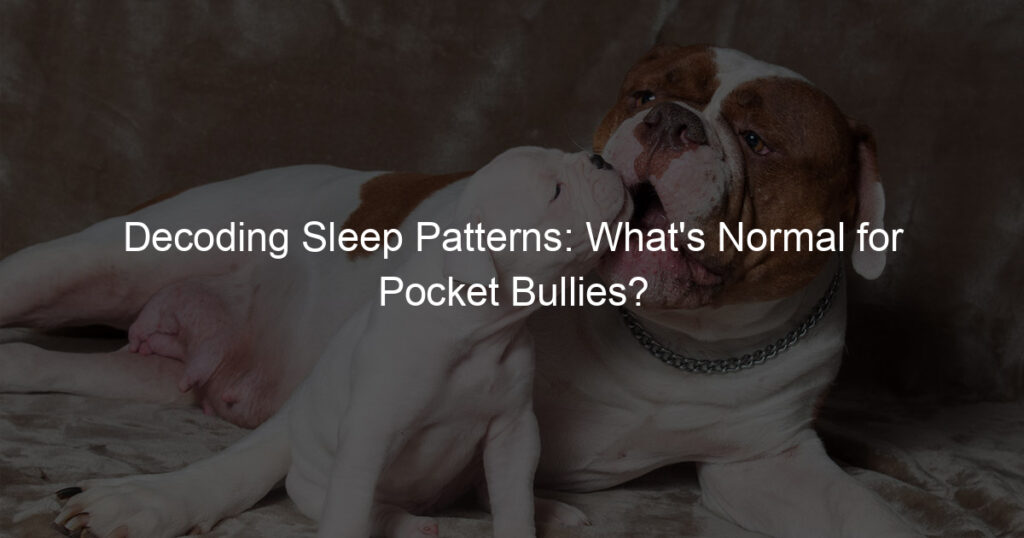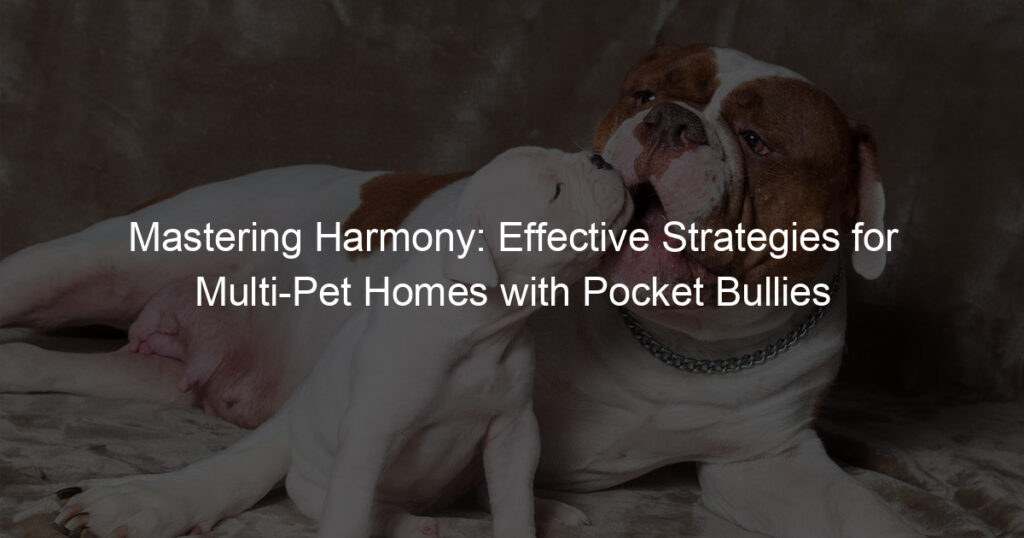
Introduction to Noise Sensitivity in Pocket Bullies
Noise sensitivity is a common issue among many dog breeds, including Pocket Bullies. It’s a condition where dogs react unusually to certain sounds, which can lead to anxiety and stress. In this article, we will delve into understanding noise sensitivity in Pocket Bullies and identifying the common signs of noise anxiety in these dogs.
- Understanding noise sensitivity in Pocket Bullies
- Common signs of noise anxiety in Pocket Bullies
Noise sensitivity in Pocket Bullies, like in other dogs, is a heightened reaction to certain sounds. It’s not just about loud noises like fireworks or thunderstorms. Even everyday sounds like the noise of a vacuum cleaner or a doorbell can trigger anxiety in these dogs. This condition can be distressing for both the dog and the owner. Understanding it is the first step towards managing it effectively.
Identifying noise anxiety in Pocket Bullies can be challenging as dogs can’t communicate their feelings like humans. However, there are some common signs that you can look out for. These include excessive barking, shaking, hiding, and even attempts to escape. Some dogs may also show signs of restlessness, like pacing around the house, while others may become unusually clingy. Remember, every dog is unique, and they may show different signs. It’s important to observe your dog closely to understand their behavior.
In the following sections, we will discuss how to manage noise sensitivity in Pocket Bullies, provide a detailed guide on noise management, and share some training tips. We will also discuss how to cope with this condition and master it for the well-being of your Pocket Bully.
Managing Noise Sensitivity in Dogs: An Overview
Noise sensitivity in dogs is a common issue that can lead to stress and anxiety for both the dog and the owner. It’s crucial to understand why managing this sensitivity is important and what strategies can be used to help your furry friend cope with noise. Let’s delve into these topics.
- Why managing noise sensitivity is important
Noise sensitivity can significantly impact a dog’s quality of life. Loud noises such as fireworks, thunderstorms, or even the sound of a vacuum cleaner can cause a dog to become fearful and anxious. This can lead to destructive behavior, such as chewing on furniture or excessive barking, which can disrupt the peace in your home.
Moreover, prolonged exposure to noise can lead to chronic stress in dogs, which can have serious health implications, including a weakened immune system and digestive issues. Therefore, managing noise sensitivity is not just about keeping your dog calm during a thunderstorm, but also about ensuring their overall health and well-being.
- General strategies for managing noise sensitivity in dogs
There are several strategies you can use to manage noise sensitivity in dogs. Here are a few:
- Desensitization: This involves gradually exposing your dog to the noise that scares them, starting at a low volume and gradually increasing it as your dog becomes more comfortable. This should always be done under the guidance of a professional to avoid causing more harm than good.
- Distraction: If a noise is causing your dog distress, try to distract them with a game or a favorite toy. This can help shift their focus away from the noise.
- Safe Space: Create a safe space in your home where your dog can retreat to when they’re feeling scared. This could be a crate with a blanket over it, a quiet room, or even a closet. Make sure this space is always available for your dog.
- Professional Help: If your dog’s noise sensitivity is severe, it may be worth seeking help from a professional dog trainer or a veterinary behaviorist. They can provide you with a tailored plan to help manage your dog’s noise sensitivity.
Remember, every dog is unique and what works for one might not work for another. It’s important to be patient and persistent in finding a strategy that works for your dog.
Pocket Bullies Noise Management: A Detailed Guide
One of the most common issues that Pocket Bullies owners face is managing their pet’s noise sensitivity. This article aims to provide a comprehensive guide to understanding and managing your Pocket Bully’s noise phobia.
Understanding Your Pocket Bully’s Noise Phobia
Noise phobia in Pocket Bullies is a serious issue that can cause significant distress to your pet. It is crucial to understand the triggers and the effects of noise phobia on your Pocket Bully’s behavior to manage it effectively.
- Identifying triggers for your Pocket Bully’s noise phobia
- How noise phobia affects your Pocket Bully’s behavior
Every Pocket Bully is unique, and so are their triggers. Common triggers include thunderstorms, fireworks, loud music, and even the sound of vacuum cleaners. Observing your pet’s behavior during different noise situations can help you identify their specific triggers.
Noise phobia can cause a range of behavioral changes in your Pocket Bully. They may become restless, show signs of anxiety, or try to hide or escape. Some dogs may even exhibit destructive behavior. Understanding these signs can help you provide the necessary support and intervention.
Understanding your Pocket Bully’s noise phobia is the first step towards managing it. The next sections will provide detailed strategies on how to reduce noise sensitivity in your Pocket Bully.
Reducing Noise Sensitivity in Pocket Bullies
Managing noise sensitivity in Pocket Bullies can be a challenging task. However, with the right approach, you can help your furry friend feel more comfortable and less stressed. Here are three effective strategies to reduce noise sensitivity in Pocket Bullies:
- Creating a safe space for your Pocket Bully
One of the most effective ways to reduce noise sensitivity in Pocket Bullies is by creating a safe and comfortable space for them. This space should be a quiet, cozy area in your home where your dog can retreat to when they feel stressed or scared. You can use a crate or a small room and fill it with their favorite toys and blankets. This will provide a sense of security and comfort for your dog, helping them cope with noise sensitivity.
- Using noise-cancelling products for dogs
Another effective strategy is the use of noise-cancelling products for dogs. These products, such as earmuffs and headphones, are designed to block out loud noises and help your dog feel more relaxed. According to a study, noise-cancelling products can reduce stress levels in dogs by up to 60%. However, it’s important to introduce these products gradually and ensure they are comfortable for your dog.
- Introducing gradual exposure to noise
Gradual exposure to noise can also help reduce noise sensitivity in Pocket Bullies. Start by playing soft noises and gradually increase the volume over time. This will help your dog get used to different sounds and reduce their fear of loud noises. Remember, it’s important to be patient and consistent with this process. It might take some time, but with persistence, your dog will eventually become less sensitive to noise.
In conclusion, reducing noise sensitivity in Pocket Bullies involves creating a safe space, using noise-cancelling products, and introducing gradual exposure to noise. By following these strategies, you can help your furry friend live a happier and less stressful life.
Noise Sensitivity Training for Pocket Bullies
Training your Pocket Bully to cope with noise sensitivity can be a challenging task. However, with the right techniques and a lot of patience, you can help your furry friend overcome their fear of loud noises. Let’s explore some of the most effective training techniques for noise fear.
Training Techniques for Noise Fear
There are two main techniques that can be used to help your Pocket Bully cope with noise sensitivity: positive reinforcement training and distraction techniques.
- Positive Reinforcement Training: This technique involves rewarding your Pocket Bully for displaying calm behavior during a noisy situation. For example, if your dog remains calm during a thunderstorm, you could reward them with a treat or a favorite toy. This method encourages your dog to associate the noise with something positive, rather than something to be feared.
- Distraction Techniques: Distraction techniques involve diverting your dog’s attention away from the noise. This could be done by playing a game with them, or engaging them in a training session. The aim is to get your dog to focus on something other than the noise, reducing their fear and anxiety.
Remember, every dog is different, and what works for one may not work for another. It’s important to try different techniques and see what works best for your Pocket Bully. With time and patience, you can help your dog overcome their fear of noise.
Professional Help for Noise Sensitivity Training
While many Pocket Bully owners can effectively manage their dog’s noise sensitivity through home training techniques, there are times when professional help may be necessary. Let’s discuss when to seek professional help and how to choose the right professional for your Pocket Bully.
- When to Seek Professional Help
- Extreme fear or panic during noise events
- Aggressive behavior triggered by noise
- Physical symptoms such as excessive panting, drooling, or shaking
- Choosing the Right Professional for Your Pocket Bully
- Experience: Look for a professional who has experience working with Pocket Bullies and noise sensitivity.
- Training Methods: Ensure the professional uses positive reinforcement methods and avoids techniques that could increase your dog’s fear or anxiety.
- References: Ask for references from other clients who have used their services for noise sensitivity training.
If your Pocket Bully’s noise sensitivity is severe and causing distress, or if your training efforts are not producing the desired results, it may be time to seek professional help. Some signs that your dog may need professional assistance include:
Remember, every dog is unique. What may seem like a minor issue to one dog could be a major problem for another. Always trust your instincts when it comes to your pet’s well-being.
When it comes to selecting a professional to help with your Pocket Bully’s noise sensitivity, it’s important to choose someone who is experienced in dealing with this specific issue. Here are some factors to consider:
Remember, the goal is to help your Pocket Bully feel safe and secure. A professional who understands this and knows how to work with noise-sensitive dogs can be a valuable resource.
Coping with Noise Sensitivity in Pocket Bullies
Noise sensitivity can be a challenging issue for Pocket Bullies. However, with the right strategies and support, your furry friend can learn to cope with this problem. Let’s explore how you can support your Pocket Bully during noise events.
Supporting Your Pocket Bully During Noise Events
When it comes to noise events, your Pocket Bully may feel anxious or scared. Here are some effective ways to comfort your pet and help them manage their noise sensitivity in the long term.
- How to comfort your Pocket Bully during noise events
- Long-term strategies for coping with noise sensitivity
One of the best ways to comfort your Pocket Bully during noise events is to provide a safe and quiet space for them. This could be a room with soundproofing or a cozy crate with their favorite toys. You can also use calming techniques such as gentle petting, soothing music, or even a comforting scent like lavender.
For long-term strategies, consider noise desensitization training. This involves gradually exposing your Pocket Bully to different levels of noise in a controlled environment, helping them become less sensitive over time. You can also consult with a professional dog trainer or a veterinarian for personalized advice.
Remember, every Pocket Bully is unique and what works for one may not work for another. It’s important to be patient and consistent in your approach. With time and effort, your Pocket Bully can learn to cope with noise sensitivity and live a happier, more comfortable life.
Case Study: Overcoming Noise Fear in Pocket Bullies
-
Introduction to the case study
Our case study focuses on a two-year-old Pocket Bully named Max. Max had an intense fear of loud noises, such as thunderstorms and fireworks. His fear was so severe that it affected his quality of life and caused distress to his owners. This case study outlines the steps taken to help Max overcome his noise fear and the results of these efforts.
-
Steps taken to overcome noise fear
The first step was to identify the specific triggers for Max’s noise fear. Once these were identified, a plan was developed to gradually expose Max to these noises in a controlled and safe environment. This process, known as desensitization, was combined with positive reinforcement. Whenever Max reacted calmly to a noise, he was rewarded with treats and praise.
Additionally, Max’s owners created a safe space for him in their home. This was a quiet, comfortable area where Max could retreat to whenever he felt scared. Over time, Max began to associate this safe space with feelings of security and calmness.
-
Results and key takeaways from the case study
After several months of consistent training and positive reinforcement, Max’s fear of noises significantly decreased. He no longer panicked during thunderstorms and was less anxious during noisy events. His quality of life improved, and his owners were relieved to see him living a happier, less fearful life.
The key takeaway from this case study is that with patience, consistency, and the right techniques, it’s possible to help a Pocket Bully overcome noise fear. It’s important to remember that every dog is unique, and what works for one may not work for another. Therefore, it’s crucial to tailor the approach to the individual dog’s needs and responses.
Conclusion: Mastering Noise Sensitivity in Pocket Bullies
As we come to the end of this comprehensive guide, it’s important to remember that managing noise sensitivity in Pocket Bullies is not a one-time event, but a continuous process. Let’s recap the strategies we’ve discussed and highlight the importance of patience and consistency in this journey.
- Recap of strategies for managing noise sensitivity:
- Importance of patience and consistency in noise sensitivity management:
We’ve discussed several strategies for managing noise sensitivity in Pocket Bullies. These include creating a safe space for your dog, using positive reinforcement, and gradually exposing them to different sounds. We also touched on the importance of understanding your dog’s body language and seeking professional help when necessary.
Patience and consistency are key in managing noise sensitivity. It’s crucial to remember that progress may be slow and that setbacks can occur. However, with consistent practice and a lot of patience, your Pocket Bully can learn to cope with noise better. It’s a journey that requires commitment, but the reward is a happier, more relaxed dog.
In conclusion, mastering noise sensitivity in Pocket Bullies is achievable with the right strategies, patience, and consistency. It’s a journey that may be challenging, but the end result is a more comfortable and happier life for your beloved pet. Remember, every dog is unique, so what works for one might not work for another. It’s all about finding the right balance and approach for your Pocket Bully.
